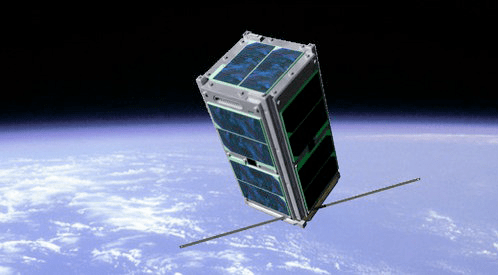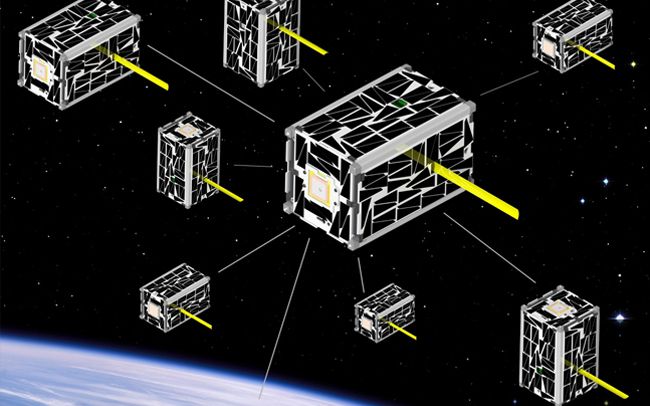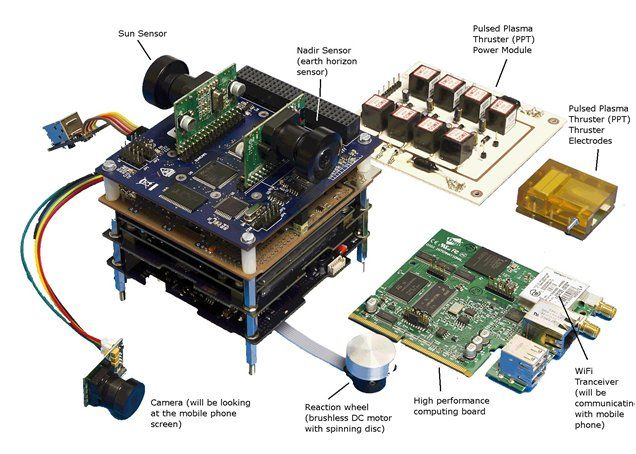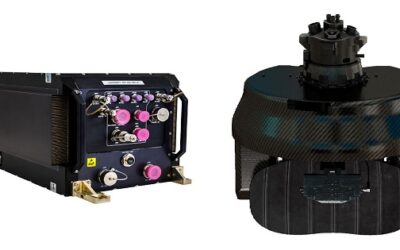Nanosat constellations for persistence & resilience representing rapidly changing space sector
Space provides critical mission access for tactical communications, missile warning, intelligence and surveillance; it has become a pervasive element of social and economic life The US Department of Homeland Security, for instance, estimates that $1.6 trillion of US revenues in 2016 derived from space. It has therefore become critical to modern defence. A substantial number of existing military satellites are nearing the end of their operational life; development and operational costs, long construction cycles and the increasingly congested and contested nature of space – as well as the prospect of hostile satellites – threaten those concerned with control of space functions.
Speed of replacement is hampered by the considerable costs. For example, a GPS (Global Positioning System) III satellite costs about US$500 million to build and 300 million to launch. Military planners are thus exploring a range of cost-cutting options for modern satellites, including technological evolution, new management strategies and the use of new launch techniques. Nano-satellites (nanosats) offer a potential solution: developed quickly, at low cost and in numbers that facilitate threat resilience, they offer some but not all of the capabilities of traditional systems. However, budget cuts have caused the day of the dedicated multi-billion dollar satellite to come to an end, including the US 2009 $12 billion TSAT programme, which heralded a shift from strategic to smaller tactical scale considerations.
Every recent study forecasts an increase in demand for bandwidth to support UAVs, wireless devices, traditional communications and a host of other advanced military applications. These studies suggest a re-examination of every aspect of military satellite communications (MILSATCOM), from the type of satellite and its dimensions, to launch methods and ground terminals, with the aim of improving efficiency and saving costs.
Reduced launch demands have resulted in over 60 nations now developing space capabilities, seeking to provide the functions of larger satellites at reduced costs. Full sized satellites can range from $200 million to 1 billion: CubeSats, by comparison, cost under $1 million. SpaceX CEO Elon Musk is on record as predicting launch costs may fall to as little as $200,000 per kilo.

Future Nano-Satellites: Operational Requirements and Technological Evolution
Nanosats offer emerging nations an ability to shorten the development-to-launch cycle. Commercial electronics have driven a capability for high volume, low unit cost highly reliable systems with low failure rates – essential characteristics for military solutions. Building low cost, reliable, rapid response nanosats, using COTS-based imaging and sensing chips will be transformational for space and challenge the status quo for decades to come. Typical is the 2012 Surrey Satellite Technology nanosat STRaND, which included a smartphone containing accelerometers, magnetometers, GPS receivers, gyroscopes, barometers and cameras, intended for testing smartphone components in space environments. Over 1,400 satellites – including nanosats – are likely to launch in 2015-2015.
The range of nanosat applications is extensive, from surveillance through communication and navigation to signal intelligence and more. Bearing operational needs in mind and considering the advanced capabilities currently at the R&D stage, it should be possible to use the small platform offered by nanosat in a revolutionary manner. Early nanosats, such as the US Space & Missile Defense Command Operational Nanosatellite Effect (SMDC-ONE) programme, demonstrated an ability for rapid design and development low-cost military space systems and revealed the following advantages:
- Significantly lower costs compared to traditional systems;
- Launch systems cheaper and simpler;
- Short cycle “from requirement to launch”,
- Large constellations are capable of revisiting sites far more frequently than current solutions.
Eight 4kg SMDC-ONE satellites were ordered from Miltec and the first was launched onboard a FALCON-9 rocket in 2010.
SMDC-ONE provided 2-3m ground resolution, sufficient to identify tanks, and could provide commanders with intelligence for rapid decision support from a C2 station, or data exfiltration from unattended sensors to other stations. Their test network included concealed seismic and passive IR sensors feeding the ground station, detected within a 1200mi LEO footprint. Other objectives included real-time voice and text messaging between forward-deployed tactical UHF radios and operational life of up to a year.
The US Army is looking to higher capacity third generation (UHF and Ka-bands) systems, such as KESTREL-EYE (strictly speaking not really a nanosat at 14kg), NanoEye and the Small Agile Tactical Spacecraft (SATS) to provide generational capabily improvements. Numerous KESTREL-EYEs will demonstrate battlefield persistent 1.5m-resolution imagery over year-long operations, within 10 minute-tasking windows.
Maryland Aerospace is building KESTREL-EYE Block II for the US Army, with first launch planned for 2017 on a FALCON-9. NanoEyes will cost $1.4 million each, less than traditional DoD programmes, whilst SATS will provide 1.5-2m ground resolution over a 3-year lifetime with three operational modes: Point and shoot –multiple imagery per pass; Scene – still images or video along pre-planned paths; or 5M pixel images with 50% stereoscopic overlap. The US Coastguard already provides Arctic situational awareness, safety and security in all-weather conditions with limited aircraft and vessels. Project “Polar Scout” is their demonstrator for mixed-government and commercial nanosatellite provision to locate emergency beacons used by mariners in distress.
Raytheon Missile Systems is developing the ability to mass produce nanosats at less than $500.000, working to DARPA’s Dec. 2016 $1.5 million award for 24 satellites with colour cameras. With reconnaissance applications in mind, Skybox already captures high-resolution imagery (90cm) whilst Planet provides 3-5m resolution, updated hourly for vehicle analysis or monitoring critical infrastructure, and timed series for observation of such phenomena as Chinese construction on the Spratly Islands. Other companies like Aquila Space have demonstrated 6kg optical and radar satellites comparable with the 3kg vehicles from Planet. In 2016 India’s PolarSat mapping satellite launch carried 12 Planet DOVE satellites. Planet can produce 100 nanosats in 18 months at low cost, to less stringent standards than traditional vehicles and with lifetimes of up to two years in LEO.
DARPA and other US government agencies are exploring and developing innovative space technologies and systems for dedicated military missions, since the use of nano-satellites in such missions has become an attractive alternative to current larger and more expensive systems and architectures. Small satellites have not only lower development and launch costs, but also provide further capability development, allowing commanders more flexible options for surveillance, communications and space control.
There are several key factors contributing to the future of nanosats:
- Launch vehicles will become more flexible, characterised by high availability and rapid deployment;
- Higher efficiency energy generation and storage;
- Further miniaturisation of high frequency/bandwidth transceivers, optics and multi- or hyper-spectral imagers;
- Higher precision navigation and control nano-sensors/actuators;
- Higher processing power.
After an experimental phase that showed how nanosats in Low Earth Orbit (LEO) could be used for advanced communications and data exfiltration, new nanosat constellations are now in development.
For example, the US Air Force Office of Scientific Research, in collaboration with DARPA and NASA, is developing a new nanosat programme to demonstrate the following capabilities:
- Formation flying;
- Tethered operation;
- Lightweight sensors;
- Nano-sensors and nano-electronics;
- Advanced communications;
- Micro-propulsion;
- Advanced lithium-ion batteries.
According to the US Army Space and Missile Defense Command/Army Forces Strategic Command’s Nanosatellite Program, these systems will allow communication across great distance using existing UHF tactical communication systems. Future nanosats and cube satellites (cubesats) weigh less than 5kg, costing around $300-500,000 and able to provide over-the-horizon capabilities. They also have multi-functional relay capability with more than five times the data rate of the first experimental nanosat. The US Army seeks to use future nanosats to provide dedicated coverage for a wide range of users in remote areas, and to allow tactical commanders to synchronise actions, seize the initiative and maintain situational awareness. The advantage of LEO lies in the satellites’ proximity to the earth, which allows for much lower signal levels using existing UHF radios. MILSATCOM has also increased its capabilities in nanosat configurations and is able to provide communication links to small, mobile, and handheld terminals. Future nanosats will provide significant capabilities for operational units, including mobility, rapid reconfiguration, high-capacity communications links for C2 and transmission of targeting and intelligence data to mobile units. Increasing MILSATCOM requirements present complex architecture challenges because of the necessity for efficient anti-jam systems to ensure jam-resistant communications – such systems, of course, to be both inexpensive and with innovative capabilities. The use of commercial systems (COMSAT) could supply capacity for increasing operational requirements, but such systems can be easily jammed or the networks degraded. Therefore a balanced architecture is needed for future nano-MILSATCOM, featuring adequate anti-jam and high-capacity characteristics.

Other important improvements include propulsion capability and the inclusion of deployable solar arrays for battery charging, thus increasing power generation and the capability for station keeping to maintain constellation spacing. Propulsion capability in future nanosats is also driven to a degree by safety issues. The major problems in nanosat missions derive from the risks related to space debris and the associated probability of in-orbit collision, their inability to manoeuvre and small size representing a risk, not only to the mission itself, but also to other space systems. The problem is exacerbated when nanosats are launched in constellations. Propulsion capability improvements therefore enhance operational characteristics and increase the capability for avoidance of debris. The ability to detect, identify, track and predict the position of space objects and debris is fundamental to the future of space surveillance – it is considered an essential component of space control and underlies the development of situational awareness in the space environment. However, due to the coverage gap in surveillance networks (radar, telescopes, communications) and the very limited size of some objects and debris, not all objects in space can be identified and monitored. Accurate orbit-prediction algorithms are therefore necessary to produce a reliable real-time space surveillance situation, producing a space picture in which the position of all objects is known with sufficient accuracy. A space surveillance system to meet modern needs would include accurate orbit-prediction algorithms and a large database to maintain a comprehensive ‘space catalogue.’ The capability to monitor space debris and objects down to 1cm diameter will allow for prevention of impact and potential satellite destruction. The volume of debris in LEO means the problem can no longer be ignored. In order to mitigate these risks, the rules established in the Space Debris Mitigation Guidelines need to be followed. The Clean Space One project, led by the EPFL Space Engineering Centre, aims to demonstrate the technologies required to actively monitor objects in LEO and is complementary to ESA’s Clean Space Initiative. Electrical propulsion systems are low- or medium-power units designed for both maintaining and changing orbit in small satellites. These propulsion systems are designed to operate at very low electrical power rates (100-250W) and are up to six times more effective than chemical propulsion, able to maintain the satellite at the appropriate altitude for longer.
Military use of commercial satellite imagery is becoming more and more common. Many countries use this option, since it is now possible to purchase satellite photos from commercial operators in black and white or colour, with resolutions of 50cm and now even 25cm available. However, modern operational requirements indicate a preferred resolution of 10-15cm to overcome the limitations imposed by atmospheric transit. Turbulence phenomenon is an atmospheric limitation, resulting from changes in air density due winds, humidity and temperature gradients, which prevent the image from the ground reaching the camera aperture at sufficient quality. It should be noted here that nano high-resolution cameras dictate the need for high processing capabilities, since they generate data at a rate of almost 6 Gigabytes/second. There is also an emerging demand for highly miniaturised high performance IR imagers for remote sensing applications, to be installed on small platforms such as UAVs or nanosats. Compact IR sensors are based on cooled detectors and cryogenic optics and the continued development of high performance IR Focal Plane Arrays, characterised by large formats in the megapixel range and packaged in compact dewar configurations (known as IDDCA or Infrared Detector Dewar Cooler Assemblies) are essential. Beyond these developments. Fresh IR micro-systems have been developed, from single axis cameras to multiple channel systems for IR mono-, multi- and hyper-spectral imagery.
It is certainly true that the military value of imagery depends on system resolution, but it is also true that the tactical value of such imagery depends on timeliness. In other words, collection and processing of imagery in near real time makes real time targeting and situational awareness possible, particularly when dealing with mobile targets. Once again, processing capabilities are fundamental.
DARPA’s current focus in nanosatellite research encompasses:
- Advanced digital control system and bus technology;
- Satellite networks;
- Swarm technologies;
- Space robotics;
- Payload technologies (optical sensors, radar, lidar, etc.);
- In-space energy generation;
- In-space ion thrust propulsion system;
- Advanced guidance, navigation and control.
This research will allow for higher computational power, higher data link capabilities, more precise orbit determination and attitude determination and control.

Launch Vehicle Considerations
Launch availability is a severe bottleneck. There are few dedicated launchers and there is excessive current reliance on ‘piggyback’ launches. Nanosats provide increased freedom, moving from ‘hitching lifts’ on rockets to potentially launching from aircraft, balloons or more efficient rocket launches requiring less capital investment and reducing risk. DARPA is working on technologies to reduce weight and improve optical surveillance reliability, exploring chemical/electrical propulsion, advanced structures, additive layer technologies, and miniature RF for communications and sensing. Although currently lacking propulsion, the design of tiny engines would allow nanosats to remain in space longer, or drive them to ‘burn-up’ on mission completion, using magnetic field accelerated ionised propellants or mixed water-alcohol propulsion systems.
The US Army backs SWORDS, a nanosat launcher derived from retired artillery rockets and providing launch facilities at $1 million per flight, while CRD Research Corporation is pioneering low-cost reusable launchers with two-stage orbit insertion, consisting of a MENACE vehicle, based on its multiple launch rocket system experience and capable of remote deployment. Pumpkin supplies military nanosat parts, including the US National Reconnaissance Office’s 12 cubesats (at $400,000 each) to monitor space weather, critical to US space warfare. Future commercial launches may be provided by Virgin Galactic’s LAUNCHER ONE, PEGASUS, or Orbital ATK.
Early nanosats were launched on traditional launchers such as ARIANE 4 and 5 as auxiliary payloads during traditional satellite launch missions. This resulted in minimal costs with high security and no interference with the primary payload, a satisfactory solution for initial operational tests but no longer appropriate, since military planners cannot contemplate using commercial launchers to meet urgent operational requirements in time. It is therefore imperative to have launchers in inventory for immediate use as required, which requires the development of economic launchers specifically designed for military needs. In fact, future nano and micro satellites will be designed for easy integration onto specific cheaper and simplified launch systems, featuring options for rapid launch within hours: reusable and expendable vehicles meeting these criteria are already in development, as are Space Operations Vehicle (SOV) systems able to provide easy, repeatable launch to orbit. Launch frequency and repeatability is a key feature in reducing launch costs.
The Airborne Launch Assist Space Access (ALASA) launch system, developed by Boeing and DARPA, is designed to be carried by an F-15. The vehicle is quite revolutionary and uses a new, innovative and exceptionally efficient monopropellant, a combination of nitrous oxide and acetylene known as NA-7. This constitutes a real change in the field of miniaturised satellites, due to the new fuel, low cost and operational flexibility: the system can be launched on demand within 15-20 hours of request. Despite the advanced features and satisfactory tests, DARPA ended the programme in 2015 due to safety problems related to the propellant, which caused two explosions during ground tests. DARPA reports that development of the propellant continues and the experience gained with ALASA will be applied in a future programme for a similar system.
Global Developments
Restricted technology access and financial limitations hampered developing countries’ previous attempts to obtain cheap and efficient space services. Now, however, there are many developing country programmes, with India, Iran, China, South Africa, and Vietnam among the nations concerned. India’s 3kg JUGNU disaster monitoring nanosatellite, developed for year-long operations at a cost of 25million rupees in 2011, was followed by the 5.3kg PISat, an 80m resolution camera launched in September 2016 and now CARTOSAT-2’s delivery of a record-breaking 104 nanosatellites in February 2017.
China’s space ambitions are clear, pursuing a burgeoning commercial and military agenda. Its programme is founded on pursuit of PLA military advantage to exercise space denial and LEO dominance. China has accessed US space technology, space corporations and government institutions since the 1990s, presenting the US with significant competitive risk. China can now develop secure constellations and replace satellites, exploiting technology to strengthen its space and military nanosat sectors, investing in Harbin Institute of Technology, Nanjing University of Aeronautics and Aerospace, and the National University of Defence Technology. In 2015 LULIANG 1 was one of 20 satellites launched on the CS-6 rocket’s maiden flight, intended for space-based AIS reception and aviation traffic management. Singapore’s key development in 2014 was nanosat and picosatellite separation for inter-satellite communications over a 2-year lifetime, using the 3.5kg VELOX-1 and 1.5kg VELOX-P3, launched in June 2014 and still operational.
Japan has strong university-based nanosat development programmes. Between 2003-2012 they produced 17, leading to the HODOYOSHI project for reliable nano/pico-satellite concepts, including miniature ion propulsion systems to provide greater thrust for low power.
Russia’s plans are unclear, but it sparked a revolution with the first 3D-printed cubesat, TOMSK TPU-120 launched to the International Space Station (ISS) in 2016. According to RAI Novosti, “This is the first 3D-printed space probe built. Further advancement of this technology will enable mass-scale production of small satellites.” Most of its components are plastic, reducing weight substantially. Other printed satellites include Printsat-SLS (launch failed in 2015) and the Rapid Manufacture of Space Exposed Structures (RAMSES) which was due to be launched in March.
The UK Government invested £1.2 billion in space since 2010, with 2015 a record year for start-up ventures investment. Having just delivered a programme to the UK MOD, the European Space Agency awarded Roke Manor Research a contract for SysNova, a nanosatellite technologies initiative and Clyde Space has secured a contract with Kepler for manufacture of two software defined radio communications nanosatellites.
The Israeli Nanosatellite Association launched its first nanosat in June 2014 – DUCHIFAT 1, whose official goal was a space studies educational platform and a search and rescue network for distress signals in areas isolated from communications infrastructure. Israel is a recognised nanotechnology leader and has more launches in prospects, quite apart from the existing BGUSAT and SPACE PHARMA programmes.
Even smaller countries like the UAE, with the NAYIF-1 satellite and Lithuania have developed nanosats: the 3kg LitSat-1 and LITUANICA SAT-1, launched from the ISS in 2014, were intended to test onboard systems and earth-satellite communications with a GPS receiver to detect signals in the Adriatic.
The ISS platform is ideal for release of satellites to lower orbits, deploying 49 satellites in 2015. Higher launch rates, however, will cause concern over potential collisions, which are high on the hierarchy of concerns that the space community currently seeks to resolve. A total of 71 nanosats were launched between November 2013 and January 2017, but not all were successful. Perhaps the most egregious and obvious example is the SpaceX ISS resupply mission to place 104 crowd-funded SPRITE cubesats (each the size of a postage stamp and carrying a radio, aerials, solar cell and instrumentation) in April 2014, which developed a fault: the entire constellation failed to deploy and burned up on re-entry.
Capability Limitations
Accessible power for a 10kg satellite is under 18W, which limits ground range and requires LEO orbits. Another restriction is processing power, which benefits to an extent from mobile phone technology. Cubesat data-buses use the limited I2C de facto COTS standard: 400kHz clock speed and 200.6kbit/s bit-rate. Capability gaps still exist, such as low-cost inter-satellite data-exchange links (optical or RF) to MILSTAR GEO-SATCOM, and small antenna gains. Laser communications may provide higher performance and efficiency above traditional RF, providing six times RF data rates (600 vs 100Mb/s in Ka-band), potentially supporting ground troop video feeds rather than pictures. Although RF is the backbone of space-based operations, lasers may provide higher data rates, halving mass and requiring less power, as was first tested with the Lunar Laser Communications Demonstration in 2013.
Budget contraction and rapid advances in a new era of miniaturisation thanks to nanotechnologies, have underpinned the development and operational use of smaller, more computationally capable satellites, complementing the conventional satellite systems still necessary for large-scale operational needs. In the space race during the Cold War, the satellite game was a clash of superpowers, but today – and in the future – smaller nations, not necessarily renowned as leaders in aerospace technology, are increasingly involved. Smaller satellites and appropriate launchers are the consequence of the “faster, better, cheaper” philosophy, but must be integrated with land/sea/air forces’ systems and their information obtained with other assets, requiring command protocols, communications standards, data fusion. Architectures with these capabilities would allow an increase in future coverage over crisis areas, with the capability to change orbit when operational necessities or fresh areas of interest dictate.
Low-cost nanosats sacrifice long lifetimes for 1-2 year design expectancy and reliability; they don’t require redundancy for long-life, nor do they need to survive harsh ‘space weather,’ as they can be rapidly repopulated. Nanosats have short, low-cost cycles and can exfiltrate data from enemy territory to embedded friendly units. Nanosat constellations provide persistence and resilience and now represent the most rapidly changing space sector. It is anticipated that change in 2017-2024 will exceed that over the last 50 years, with a new international nanosat space-race, driven by revolutionary and adaptable electronics technologies and new innovative launch providers, well underway.
Christopher Lavers & Paolo Quaranta

























